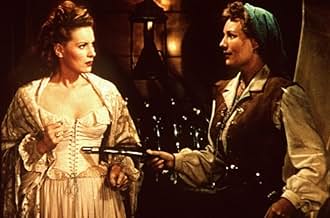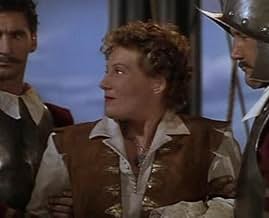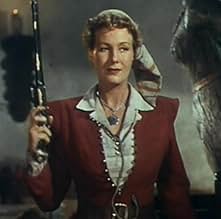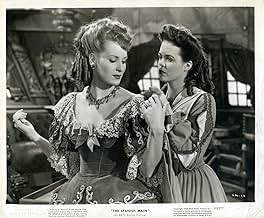NOTE IMDb
6,3/10
2 k
MA NOTE
Ajouter une intrigue dans votre langueAfter being wronged by the Caribbean authorities, a Dutch captain turns pirate to wage war.After being wronged by the Caribbean authorities, a Dutch captain turns pirate to wage war.After being wronged by the Caribbean authorities, a Dutch captain turns pirate to wage war.
- Réalisation
- Scénario
- Casting principal
- Nommé pour 1 Oscar
- 1 nomination au total
Jack La Rue
- Lt. Escobar
- (as Jack LaRue)
Demetrius Alexis
- Officer
- (non crédité)
Don Avalier
- Pirate
- (non crédité)
Martha Bamattre
- Innkeeper
- (non crédité)
Avis à la une
Paul Henreid apparently wanted his home studio Warner Brothers to make this, but in 1944, that studio was firmly committed to making large -scale war films, and besides, its number one star was Errol Flynn who was (and is) THE swashbuckler. So Henreid took it to RKO and, through a contractual sleight of hand, negotiated his release from Warners to make it at this normally low-budget studio. He should not have bothered.
The main problem with the film is that its central role is miscast. Henreid is both too effete and a bit too old for the part, and next to Miss O'Hara (who as usual, looks ravishing in colour) rather bland and lifeless. He is also clearly doubled in some of the duels.
The music score by Hanns Eisler (a surprising choice) is gestural note-spinning with not one memorable theme to sweep us along. He should have watched The Sea Hawk and listened to Korngold's thrilling score to see how this should be done.
As usual, Walter Slezak effortlessly steal every scene he is in and is a delight. When he is not on screen, the film sags. No wonder he was cast in so many similar roles in the 1940s.
This was RKO's first colour film but most prints I have seen are very poor - either faded, or overly gaudy as a result of the three-strip technicolor separations becoming unstable and running together. It is unlikely to be restored as I doubt the original elements survive.
The ingredients were all there but refused to gel somehow. Maybe if Jack Warner had said yes, it might have been better - and Korngold would have jumped at the chance I am sure! The supporting cast is full of familiar faces (J.M.Kerrigan, Jack La Rue, Curt Bois, Mike Mazurki, Antonio Moreno) and they provide some badly needed substance in this weak entry in the genre.
The main problem with the film is that its central role is miscast. Henreid is both too effete and a bit too old for the part, and next to Miss O'Hara (who as usual, looks ravishing in colour) rather bland and lifeless. He is also clearly doubled in some of the duels.
The music score by Hanns Eisler (a surprising choice) is gestural note-spinning with not one memorable theme to sweep us along. He should have watched The Sea Hawk and listened to Korngold's thrilling score to see how this should be done.
As usual, Walter Slezak effortlessly steal every scene he is in and is a delight. When he is not on screen, the film sags. No wonder he was cast in so many similar roles in the 1940s.
This was RKO's first colour film but most prints I have seen are very poor - either faded, or overly gaudy as a result of the three-strip technicolor separations becoming unstable and running together. It is unlikely to be restored as I doubt the original elements survive.
The ingredients were all there but refused to gel somehow. Maybe if Jack Warner had said yes, it might have been better - and Korngold would have jumped at the chance I am sure! The supporting cast is full of familiar faces (J.M.Kerrigan, Jack La Rue, Curt Bois, Mike Mazurki, Antonio Moreno) and they provide some badly needed substance in this weak entry in the genre.
Greatly enjoyed this film from the past with all the actors looking so young and with great careers on the silver screen for many years. Maureen O'Hara, (Contessa Francesca), "The Black Swan", played the role of a sweet charming young lady going to be married to Don Juan Alvarado(Walter Slezak), "Born to Kill", who was a rather over weight and constantly was eating. As Contessa travels on the open seas, she comes face to face with Capt. Laurent Van Horn, (Paul Henreid),"Casablanca", who plays sort of a Robin Hood of the seas and steals from the Spanish. Capt. Van Horn desires to go to America and settle in the Carolina's but Don Juan Alvarado does everything in his power to stop him from interfering with his marriage plans to Contessa Francesda. There is plenty of action with swords and antique pistols and girls who have trouble trying to fire them off. Great Classic film and very entertaining.
10lora64
I am a great admirer of all the movies that Maureen O'Hara has starred in. This film represents one more entertaining and absorbing swashbuckler typical of its day wherein you have a Ms O'Hara and Paul Henreid turning in excellent performances. The plot and love interest are easily assimilated and believable. If a movie holds your attention throughout like this one does, there's no question that it's worth the time and popcorn! Movies are made to be enjoyed and appreciated, and I'm sure the public knows what is enjoyable because such old movies are still in circulation, and that speaks for its quality.
I saw this on TV TCM today and will always enjoy the exciting story of the Spanish Main; with beautiful musical score and scenes rather well staged. Maureen O'Hara and Paul Henried are great! The scene stealer of course is that great character actor Walter Slezak, who plays a mean egocentric governor, but who gets it in the end. The duelling scenes are particularly good, and Paul Henried does a good job duelling. Binnie Barnes, who I remember so well in early films was especially great as a woman pirate
I had foolishly missed out quite recently on this one on late-night Italian TV and, consequently, was very glad now to get acquainted with it (albeit via a slightly washed-out print on DivX) – especially since I was surprised by its quality, making the film an underrated entry in the swashbuckling genre. Borzage was an unusual choice for this type of film – despite being a distinguished Oscar-winning director, he has become with time a largely forgotten figure but his reputation has deservedly soared of late among film connoisseurs and is now generally comparable to that of Douglas Sirk. To be sure, he is more renowned for movies like THREE COMRADES (1938) and THE MORTAL STORM (1940) rather than fluff pieces like THE Spanish MAIN, but that only goes to show how versatile he was, equally capable of handling personal projects and genre pictures.
Equally unlikely was the film’s choice of leading man: Paul Henreid, playing an honest man who turns buccaneer in the face of injustice, his character is similar to that of Captain Blood (in spite of an obvious lack of emphasis on the actor’s agility) but also to Henried’s signature role of French Resistance leader Victor Laszlo in CASABLANCA (1942). This alone makes it interesting viewing but, thankfully, they’re supported by solid talent on both sides of the camera (the actors – Maureen O’Hara in her prime, an unusually but effectively cast Binnie Barnes as a hardened lady buccaneer and O’Hara’s romantic rival, splendid villainy from Walter Slezak, John Emery and Barton MacLane being equally dastardly, J.M. Kerrigan, Curt Bois and Mike Mazurki as Henreid’s sidekicks, a script co-written by CITIZEN KANE [1941]’s Herman J. Mankiewicz, magnificent color photography by George Barnes, etc).
While the plot offers no real surprise or undue complexity – coming at the tail-end of WWII, it must have provided just the right dose of escapism – it’s professionally-handled entertainment (at which Hollywood excelled during its golden age) of the kind ‘they don’t make anymore’…despite the best intentions of today’s exponents!
Equally unlikely was the film’s choice of leading man: Paul Henreid, playing an honest man who turns buccaneer in the face of injustice, his character is similar to that of Captain Blood (in spite of an obvious lack of emphasis on the actor’s agility) but also to Henried’s signature role of French Resistance leader Victor Laszlo in CASABLANCA (1942). This alone makes it interesting viewing but, thankfully, they’re supported by solid talent on both sides of the camera (the actors – Maureen O’Hara in her prime, an unusually but effectively cast Binnie Barnes as a hardened lady buccaneer and O’Hara’s romantic rival, splendid villainy from Walter Slezak, John Emery and Barton MacLane being equally dastardly, J.M. Kerrigan, Curt Bois and Mike Mazurki as Henreid’s sidekicks, a script co-written by CITIZEN KANE [1941]’s Herman J. Mankiewicz, magnificent color photography by George Barnes, etc).
While the plot offers no real surprise or undue complexity – coming at the tail-end of WWII, it must have provided just the right dose of escapism – it’s professionally-handled entertainment (at which Hollywood excelled during its golden age) of the kind ‘they don’t make anymore’…despite the best intentions of today’s exponents!
Le saviez-vous
- AnecdotesIn defiance of studio tradition, hairy-chested Paul Henreid refused to submit himself to the usual waxing, and appears throughout the film bare-chested and open-shirted with his furry chest intact.
- GaffesThe Governor, upon meeting the Contessa for the first time, wants to see the Barracuda, who is still aboard his pirate ship. He wants to meet him "at once", and she accompanies him. The next scene, arriving by dinghy to the ship, he is in the same uniform he left his office, while the Contessa wears a new outfit, and hair-dress with adornments that could have taken hours to redo.
- Citations
Don Juan Alvarado: My dear child, there is no reason why we shouldn't be married tomorrow.
Contessa Francesca: Tomorrow, your excellency?
Don Juan Alvarado: Well, yesterday, unfortunately, is impossible.
- Crédits fousOpening credits prologue: The Spanish Main--cruel, oppressive and ruthless, where power alone was a man's single title to everything he held dear, including his very life. It was, thus, a cruel fate that a peaceful Dutch pilgrim ship should be driven there by torrential waves--and crash upon the rocks immediately outside Cartagena, its most remorseless citadel.
- ConnexionsFeatured in Barbe-Noire le pirate (1952)
- Bandes originalesWhat Shall We Do with the Drunken Sailor?
(uncredited)
Traditional sea shanty
Meilleurs choix
Connectez-vous pour évaluer et suivre la liste de favoris afin de recevoir des recommandations personnalisées
- How long is The Spanish Main?Alimenté par Alexa
- Has anyone noticed that the battle at sea sequence was reprised (used) by 'Blackbeard the Pirate' in 1952? If I'm not mistaken Cartagena also became Port Royal.
Détails
Box-office
- Budget
- 2 000 000 $US (estimé)
- Durée1 heure 40 minutes
- Couleur
- Rapport de forme
- 1.37 : 1
Contribuer à cette page
Suggérer une modification ou ajouter du contenu manquant

Lacune principale
By what name was Pavillon noir (1945) officially released in India in English?
Répondre

































